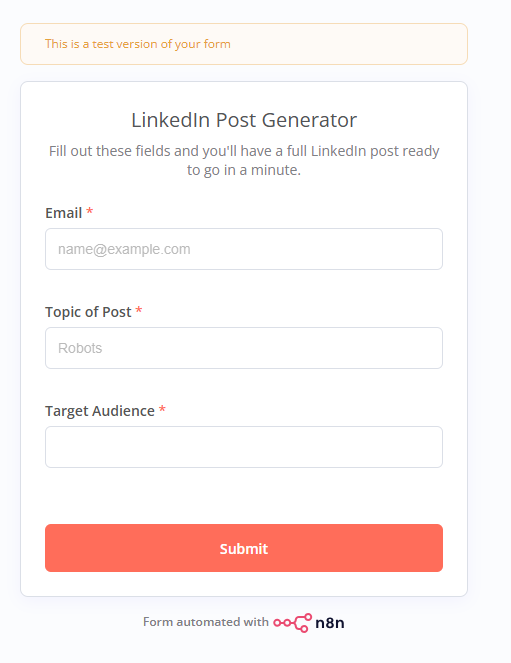How to Automate LinkedIn Posts with AI: From Idea to Graphic in Minutes
Over the past few months, AI has gone from a shiny toy to a true productivity engine. We’ve all seen the LinkedIn feeds filled with AI-generated Pixar-style headshots and creative profile pictures. But beneath the surface, the real potential of AI lies in how it can save hours for marketing teams by automating content creation.
In this article, I’ll walk you through a workflow I built that turns a simple idea into a fully researched LinkedIn post with a professional graphic — all in under a minute.
Why This Matters
Traditionally, creating a LinkedIn post involves multiple steps:
Research the topic.
Write a post in a professional format.
Design a supporting graphic in Canva or Figma.
This can take 20–30 minutes per post. But with AI APIs, we can compress this entire process into a few seconds.
Step 1: The Workflow Inputs
It all starts with a simple form:
That’s all the workflow needs to kick off.

Step 2: Researching with Tavily
The first AI agent uses Tavily Search, a web research API that brings in fresh and relevant data. This ensures the posts are backed by actual research instead of guesswork.
Example: For the topic “Junk Food vs healthy Food”, Tavily found a Deloitte study showing 25% productivity gains in companies supporting employee well-being.
Step 3: Writing the LinkedIn Post
Next, GPT-4 (via OpenAI) takes the research and turns it into a polished, professional post.
So instead of AI “slop,” you get something research-backed and worth publishing.
Step 4: Turning Posts into Graphics
Here’s where things get exciting. The second agent reads the LinkedIn post and transforms it into a text-to-image prompt.
For example:
A split-screen infographic: left side sunrise with Morning Larks +10% Productivity, right side night sky with Night Owls Thrive in Flexibility.
That prompt is then sent to OpenAI’s Image Generation API. Within seconds, we get a ready-to-use, professional-looking LinkedIn graphic.
Step 5: Automation with N8N
All of this runs inside N8N.
No manual copy-pasting. No Canva. Just results.

Cost Breakdown
Each run cost me around $0.17 — less than a cup of tea. For marketing teams, that means replacing 30 minutes of work with 30 seconds of automation, while still delivering research-backed, on-brand content.
Why This Is a Game-Changer
This workflow isn’t just about making posts faster. It’s about:
For solopreneurs, startups, and agencies, this is a superpower.
Want to Try It Yourself?
I’ve made the full workflow available as a free download. 👉 Join my AI University Skool Community, search for this workflow, and grab the JSON template.
Import it into N8N, connect your API keys, and you’ll be generating LinkedIn-ready posts in no time.
💡 The bottom line: AI isn’t just about fun images. It’s about saving time, reducing costs, and creating content at scale.